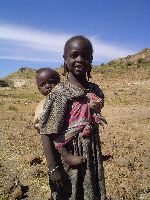Women's Leadership in Peace and Security: an Insecure Agenda
Women's Leadership in Peace and Security: an Insecure Agenda
One of the rare positive impacts of armed conflict on gender relations is the increased movement, mobility and opportunities for women in political spaces for leadership in constructing and reconstructing peace in the society during conflict and post conflict situations. Women's participation in conflict is multi-dimensional. Women play multiple roles in an armed conflict such as combatants, mediators, sleeper cells, informants, armed forces, nurses, peace negotiators and rights activists. Armed conflict affects women's life in different ways. However, the prominent portrayal of women in an armed conflict situation is mostly as victims and survivors. Their leadership role in peace building as agents of change and their contribution is completely marginalised, often ignored and uncounted for various reasons.
The feminist movement in the 1970s against the use of sexualised violence as a weapon of war gained momentum, encouraging a discourse on the prevention of sexualised violence. This later influenced international human rights jurisprudence. Sexualised violence in armed conflict is as old as the practice of conflict as a resort of resolution. However attention to address this as an issue is comparatively new. It was only during the 1950s that the issue began to emerge in the human rights discourse. The campaign by 'Comfort Women' brought forth the issue of sexual violence against women in war. This campaign and the demands of justice for past crimes influenced a series of reforms in international criminal law.
The International Criminal Tribunal of former Yugoslavia (ICTY), International Criminal Tribunal of Rwanda (ICTR) and the International Criminal Court (ICC) recognised sexual violence in armed conflict situations and criminalised such acts in an effort to end the culture of impunity. The ICTY and the ICTR codified sexual crimes in armed conflict situations and pronounced penal sanction for these crimes. The ICTR judgment in the case of Jean Paul Akeyesu (Case No ICTR -96-4-T) marked a watershed in the development of the treatment of sexual crimes during internal armed conflict situation. Rape in armed conflicts was till late penalized under the categories of the offences of 'Crimes against Humanity' and 'Genocide". For the first time the Akeyesu judgment, categorized the offence of rape during armed conflict as a 'war crime'.
The Rome Treaty of 1998 which established the permanent International Criminal Court has adopted a similar codification of sexualised violence. The treaty categorises rape, sexual slavery, enforced prostitution, forced pregnancy, enforced sterilization, or any other form of sexual violence of comparable gravity as 'crimes against humanity' and establishes individual criminal responsibility for any crimes committed under the Treaty.
However these remarkable developments didn't promote or recognised women's leadership in peace building.
In the South Asian context, violent armed conflicts increased the number of women as victims. For example, the Bangladesh war of independence exhibits how sexual violence was used to propagate strategic military purposes. The war resulted into nearly 200,000 women being used as sexual slaves. They were later given 'recognition' as 'Birangana' (War Heroines). The government run special project for them allocated monetary rewards for men on becoming their husbands. The project did not run successfully and the majority of women preferred to remain unmarried or to live with their rapists. At the end of the brutal war, only two women were declared as Mukti Jodhdha (freedom fighters). Armed conflict in pockets of the country remained even after the independence without formal acceptance of the fact.
The portrayal of women as victims remains prominent even among the standard setting practice with international bodies like United Nations. The Convention on Elimination of all forms of Discrimination Against Women (CEDAW), a prominent convention dedicated to ensure elimination of all forms of discrimination against women, is a widely used tool in advocating gender rights. It is one of the most signed conventions with 187 state parties. However, even this convention did not explicitly talk about the peculiar situation of women face during and after violent armed conflict and their roles in peace building. It was only in 2013, after an existence of almost 33 years, that CEDAW came up with a general recommendation to ensure women's participation in peace and security issues. CEDAW adopted General Recommendation 30 in October 2013 on women in conflict prevention, conflict and post-conflict situations creating an obligation for member state parties to ensure the participation of women in the peace process.
The major world's conferences on women's rights (Mexico, 1975, Copenhagen 1980, Nairobi 1985, Beijing 1995) too focused mostly on the women's victim mode and talked of the empowerment of women's leadership only remotely.
United Nations Security Council, a prominent body in the UN system dedicated to uphold peace and security in the world, made a paradigm shift and recognised women's leadership in 2000's and adopted resolutions on women, peace and security. Resolution 1325 (UNSCR 1325) adopted in 2000 by the Security Council is a widely known resolution that recognises women's roles and potential for contributions in the peace process. The resolution has four 'pillars' coined as Participation, Protection, Prevention, and Relief and Recovery. It calls for the increased participation of women at all levels of decision-making, not only in national, regional, and international institutions but also in other mechanisms engaged in prevention, management and resolution of conflict and in peace negotiations and in peace operations as soldiers, police and as agents of the UN. The resolution also calls for the protection of women and girls from sexual and gender-based violence during armed conflict situations through preventive strategies against violence against women by ending impunity, strengthening women's rights under national law and encouraging local women's initiatives for peace and conflict resolution. However, though the resolution is strongly worded, it's implementation relies on the sweet will of the UN member countries. There is no implementation and monitoring mechanism or bench marks set up allowing the state parties to get away with obligations.
Building on this momentum generated by the UNSCR 1325, the Security Council continued to adopt several other resolutions in the subsequent years highlighting the victim mode of women in conflict situation. Resolution 1820 adopted in June 2008 focuses specifically on sexual violence in situations of armed conflict and 'demands the immediate and complete cessation by all parties to armed conflict of all acts of sexual violence against civilians'. Some of the remarkable resolutions in the same line adopted by Security Council, are 1888 (2009), 1889 (2009), 1960 (2010) and 2106 (2013).
One of the main reasons of not recognising women's role in armed conflict situation is that of non-recognition of the existence of the armed conflict situation itself. In a study entitled 'The Contested Corners of ASIA: Subnational Conflict and International Development Assistance' by the Asia Foundation, it is revealed that the conflict of the nature of subnational conflict is the most widespread, deadly and enduring form of conflict in Asia. The report says, 'over the past 20 years, there have been 26 subnational conflicts in South and Southeast Asia, affecting half of the countries in this region. These conflicts are among the world's longest running armed struggles, often lasting for multiple generations, and more than 40 years on average. Within Asia, subnational conflicts have been the most common form of armed conflict since 1955 with 60\% of the world's active subnational conflicts in the past decade affecting 50\% of countries are in South Asia and South East Asia'.
Violent armed conflicts in Sri Lanka, Indonesia, Philippines, Burma, Pakistan, Afghanistan, India, and Bangladesh are continuing for years, affecting a major portion of the population in multiple ways. In India, central states, north eastern states and the Jammu and Kashmir region remained under violent armed conflict for decades without any formal acceptance by the country. In fact, India in its report to the Committee on Convention on Child's Rights (CRC) in 2005 denied the existence of any armed conflict in the country.
In Nepal, the Maoists movement ending in 2006 encouraged women to participate as combatants. Conflict induced poverty equally compelled them to do so. The presence of international agencies in the initial peace building period in Nepal in post 2006, encouraged the adoption of a National Action Plan (NAP) on UNSCR 1325. Nepal became the second country in Asia to adopt such an action plan after the Philippines. The Governing Council of the National Judicial Academy of Nepal adopted a resolution for mainstreaming gender equality issues in its policy and practice, as part of its legal reforms in the country. Indonesia and Japan are the two other Asian countries in the process of similar adoption of a NAP. However, the adoption of an NAP among the UN members states remains slow. So far 25 countries have adopted a National Action Plan (NAP) to implement UNSCR 1325.
The position of women and their situation in such conflicts is affected by what experts point out as 'a result of deep-rooted structural problems: discrimination, inequalities, collusive power structures and development agenda impacting multiple generations'. Despite, the adoption of affirmative actions by several countries for the emancipation of women their status remains unequal reinforcing subordination at every leave. For example, poverty is feminized at present with women constituting about 70\% of world's poor. About 80\% of world's unpaid labour is performed by women. Though the world comprises of nearly 50\% of women, an equitable representation of women in politics and governance is still a distant reality. They remain unrepresented in grassroots, national, regional and international governance architecture.
The leadership of women in peace and security processes remains an insecure agenda. Space for engaging in a constructive manner is remote. Women's organisations need to intensify advocacy towards the Post 2015 agenda in order to ensure that gender, social, cultural, economic and ecological justice, sustainable development and inclusive peace becomes a part of it. Strengthening the influence of the Commission on the Status of Women, rigorous implementation of obligations under CEDAW and other policy documents like the Beijing Platform for Action could be the possible arenas for meaningful engagement. Time is very limited and the goals are miles away.
Ends


 UN News: Ceasefire The Only Way To End Killing And Injuring Of Children In Gaza
UN News: Ceasefire The Only Way To End Killing And Injuring Of Children In Gaza ICHRP: US-Japan-Philippines Trilateral Summit Makes The Philippines A Battlefield For US-China Conflict
ICHRP: US-Japan-Philippines Trilateral Summit Makes The Philippines A Battlefield For US-China Conflict East West Center: Environmental Journalist Alexander Kaufman Receives East-West Center’s Inaugural Melvin M.S. Goo Writing Fellowship
East West Center: Environmental Journalist Alexander Kaufman Receives East-West Center’s Inaugural Melvin M.S. Goo Writing Fellowship Compassion in World Farming: Octopus Farm Must Be Stopped, Say Campaigners
Compassion in World Farming: Octopus Farm Must Be Stopped, Say Campaigners UN News: Shipwreck Tragedy Off Djibouti Coast, Drone Attacks Continue At Ukraine Nuclear Plant, Madagascar Cyclone Update
UN News: Shipwreck Tragedy Off Djibouti Coast, Drone Attacks Continue At Ukraine Nuclear Plant, Madagascar Cyclone Update UN News: Aid Lifeline Reaches Sudan's Darfur Region In Bid To Avert ‘Hunger Catastrophe’
UN News: Aid Lifeline Reaches Sudan's Darfur Region In Bid To Avert ‘Hunger Catastrophe’